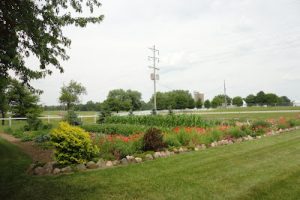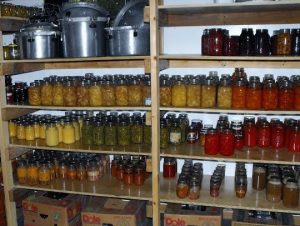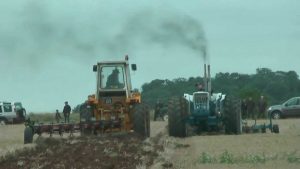Plant a Garden, Save a Planet
Ashley Brown

Pick a random road in Lagrange County, Indiana, and you will drive by big farmhouses with massive, pristinely weeded gardens full of blossoming flowers and rows upon rows of fruits and vegetables. Lagrange County has the biggest Amish population in Indiana, and the third-largest in the United States (Amish America, n.d.). Lagrange County also happens to be where I grew up, and I’ve observed a lot about the Amish way of life, including their gardening techniques. Most Amish women plant annual gardens, since planting a garden is a part of Amish culture and is treated as a priority in their daily lives. While other cultures also plant gardens, gardening is an integral part of Amish culture; the practice helps them remain largely self-sufficient year-round, keeps their grocery store produce consumption low, and is a great example of sustainable living.
Amish Gardening 101
Throughout the summer, you can find Amish women and children tending to their gardens. Even though this is a standard summer activity for the Amish community, the gardening work starts well before the summer hits. During the fall and winter months, I often see plants still present in Amish gardens and have learned that many Amish plant specific crops in the winter after the fall harvest to protect the soil and return nutrients depleted from the plants grown that year. This system provides a natural way to keep their soil in balance for the next year without the use of harsh chemicals and fertilizers. The Amish also plan ahead in their gardening by planting many of their crops before the last frost. Although this might come as a surprise – as frost can damage and kill crops – the Amish plant earlier in the year so they have a larger harvest throughout the summer and simply cover the crops at night to protect from frost.
Gardening is not an easy skill to develop, so the widespread culture of Amish gardening is impressive. The gardening knowledge and expertise of the Amish has been passed down through generations.The gardening knowledge and expertise of the Amish has been passed down through generations, as the practice is often a family activity. Amish gardeners avoid modern technologies, like fancy fertilizers or gas-powered tillers; instead, they till, plant, weed, and harvest their gardens by hand and have developed gardening methods that allow them to do so successfully. For example, many Amish will stomp down the soil between their planted rows to prevent weeds, giving them more time and energy to more thoroughly weed closer to their crops. In addition, the Amish use manure from their own animals as fertilizer, allowing them to skip the process of going to a store to purchase more synthetic fertilizers. These tips and tricks are learned at a young age, as children are often seen helping their mother weed and plant gardens as they are learning to walk up through the time when they get married and leave the house.

The Amish not only eat the produce from their gardens during the summer, but they also preserve their food through learned processes. Throughout the summer, the Amish eat fresh produce straight from their garden, sell their produce at stands by the road, or take it to local markets to be sold. In addition, the Amish can much of their food for the winter, including everything from typical canning foods like green beans or peaches to foods not typically canned such as meat. By both eating produce straight from the garden and canning food to save for winter, the Amish are able to live a fairly self-sustainable lifestyle. This self-sustainability is also a result of the large size of their gardens, as “the average garden of most Amish affiliations studied were at least two to three times larger than the equivalent English average garden,” (Amish America, 2020). Although they will sometimes purchase produce not native to Indiana, like bananas, the majority of their yearly diet is grown in their own yard.
These gardens are not just functional for self-sufficiency. The harvested produce is also free of preservatives and other chemicals found on produce grown across the world and shipped to your local grocery store. These chemicals are used when mass-producing crops to improve everything from size and shape to yield and preservation, but they can be harmful to both our bodies and our planet. Planting a garden is a viable option for avoiding these chemicals and has potential to help reduce the harmful environmental effects of industrialized farming. Industrialized farming can harm the environment in many other ways, and planting your own garden allows you to reduce these environmental impacts.
The Environmental Effects of Industrialized Farming
Farming is as much of a business endeavor as it is agricultural expertise. As a result, some industrialized farming techniques are more focused on generating revenue than growing safe, environmentally sustainable crops. Farmers often use nitrogen fertilizer, pesticides, While typical farming practices help keep the prices of our food low, they have harmful effects on our environment.and gas-powered machinery to improve efficiency in the farming process as well as the improving the quality and quantity of their crops. While typical farming practices help keep the prices of our food low, they have harmful effects on our environment.
Nitrogen Fertilizer
Nitrogen fertilizer is a mix of hydrogen and nitrogen to create ammonia which is put into the soil to replenish the nutrients crops use up when they are grown (The Mosaic Company, n.d.). When too much nitrogen fertilizer is put into the soil, it can cause runoff into water sources and render the water undrinkable. Not only does this pose issues for people with wells, which applies to many people in rural areas, but that water should also not be used for irrigating the crops and raising the livestock that we eat. In addition, the chemicals released in nitrogen fertilizer damage the ozone layer in the earth’s atmosphere. According to the Cary Institute of Ecosystem Studies, “nitrification releases a small amount of nitrous oxide which mixes into the stratosphere, where it destroys ozone,” (2015). This nitrification, or the use of nitrogen fertilizer, contributes to the breakdown of the ozone layer which has been a popular environmental point of conversation in recent history as it is thought to be connected to global warming and other climate issues. Since farming has become increasingly centered around monetary incentives, farmers are not worried about their practices as long as their crops are in demand and sell for a good price; however, individual gardeners generally do not have these issues to worry about, meaning that they are not as motivated to use nitrogen fertilizers. By planting your own garden and balancing your soil using methods like crop rotating, nitrogen fertilizer use can be minimized or eliminated altogether.
Pesticides
Pesticides are widely used to keep unwanted creatures – insects, vermin, etc. – out of the way to produce a successful crop. These pesticides often contain chemicals that are harmful in several ways. Similar to nitrogen fertilizer, pesticide runoff poses a contamination threat to our water sources, including wells, rivers, and lakes. In addition, pesticides kill off targeted pests, but they can also kill off other living things like vegetation and beneficial insects (Aktar, 2009). Killing off beneficial insects is particularly concerning, because food chains and ecosystems are affected and off-balance when a species is removed, causing a domino effect of issues that can have a lasting effect on the balance of the local environment. By planting a garden, individual gardeners have control over what pesticides are used; when money and cosmetic value are not a factor of the produce grown for personal consumption, the amount of pesticides can be greatly reduced.
Gas-Powered Farming Machinery

If you live in the Midwest, chances are high that you have seen a tractor, combine, or plow driving through a field. Gone are the days of using horse-drawn equipment – unless you are from places like Lagrange County – and farming technology continues to modernize rapidly. These pieces of machinery use gas, with over two thirds of them burning diesel fuel (Diesel Technology Forum, n.d.). When heated in the engine, exhaust is released into the air and causes pollution. Farmers use their machinery for every step of the process: plowing, planting, fertilizing, irrigating, maintaining, harvesting, and turning under. When farmers have hundreds of acres of farmland to cover, you can imagine the amount of exhaust being expelled into the air we breathe. In addition, the popularity of organic produce has caused a decrease in efficiency in field work, since organic foods have stipulations about what chemicals are allowed in the farming process. This decrease in efficiency, while mitigating the effects of things like nitrogen fertilizer and pesticides, can lead to an increase in air pollution from farming machinery per piece of produce. To combat this, having a personal garden can decrease the demand for produce in stores, resulting in a decrease of diesel emissions from farming machinery used by industrialized farmers.
Soil Erosion
Soil erosion is the result of natural things like wind and water moving topsoil away from its initial location. While this may seem harmless, soil erosion over long periods of time and over large areas of land can have a massive effect on the natural balance of our planet. For example, soil erosion often leads to contaminated waterways, as soil erosion is often a result of runoff from rain or watering crops. Because farmland is wide open with soil continuously exposed to wind and water, soil erosion is a problem industrialized farmers experience. Not only does soil erosion contaminate water, but it can also damage the land itself. According to an article published on the Iowa State University Extension and Outreach website, soil erosion “may become so severe that the land can no longer be cultivated and must be abandoned,” (Al-Kaisi, 2009). When this happens, According to an article published on the Iowa State University Extension and Outreach website, soil erosion “may become so severe that the land can no longer be cultivated and must be abandoned,” (Al-Kaisi, 2009).farmers are forced to move their farms somewhere else or try to find a way to combat the soil erosion before it becomes too extreme. Soil erosion is a serious problem in industrialized farming that has potential to ruin the agricultural system and the environment as it is now. Although having a garden exposes soil to the wind and rain that contribute to soil erosion, it is unlikely to harm waterways on a large scale compared to the soil erosion that results from industrialized farming.
Why Plant a Garden?
Planting your own garden has many positive implications for you and the environment. By planting a garden, not only do you get to choose your favorite fruits and vegetables to grow, but you also reduce the amount of produce you buy from a store. In an ideal world, this contributes to a lower demand for those crops, which in turn reduces pressure for farmers to grow as much as physically possible. This lower demand gives farmers the chance to focus on creating more sustainable farming methods. Also, eating food grown in your own backyard can help acclimate your palate to eating in season foods found locally rather than produce grown on other continents. This could help shift the focus of agriculture back to its original purpose to sustain human life and away from creating a profit and functioning as a corporate entity.

In addition, you have full knowledge of what water, fertilizers, etc. are used to grow your produce. Stores like Walmart or Kroger sell produce grown across the world, meaning that the consumer has no idea what all went into that bag of apples or head of lettuce. To add to this imbalance of information, produce labels often do not list what chemicals are used on these foods. I went to a local Kroger in Bloomington, IN and took note of what chemicals and pesticides were mentioned on the labels of the produce; much to my dismay, none of the labels on the squash, bell peppers, tomatoes, grapes, or watermelon I looked at mentioned anything about what chemicals or pesticides were used on the product. Although some digging online may surface the answers I was looking for, the common consumer is not going to take the time to research what is on their fruits and vegetables. However, eating produce straight out of a garden planted and cared for by yourself ensures that you have complete knowledge of what you are consuming. There would not be a need to use heavy chemicals, nitrogen fertilizer, or excessive pesticides on a garden, as manually weeding, tending, and crop rotation is often enough to produce a successful yield. In addition, you would not need to add chemicals to your produce to maintain the cosmetic value needed when shipping globally. Overall, planting a garden has significant benefits, giving you greater control over how the produce you consume is grown and preserved, and it can help the environment at the same time.
Although planting a garden seems like an obvious solution to the environmental problems caused by industrialized farming, gardening is an opportunity not often given by today’s societal structure. Simply put, not everyone has the space, time, knowledge, or resources to have a garden, let alone a garden big enough to reduce consumption from stores by any significant amount. Although gardening is a skill that has been around throughout human history, our society is structured in such a way that routinely tending to a garden is often not feasible and not prioritized as a life skill.
Perhaps that is why the Amish are so well-known for having magnificent gardens; their lifestyle reflects an old way of life before modern technology and social structure drove the culture away from self-sufficiency. Amish gardens are sustainable because of the time and energy put into them, and not having that time or energy presents an obstacle to a successful garden. Is gardening the perfect solution to the environmental problems caused by industrialized farming? For a lot of people, that answer is no. For others, however, gardening may provide the opportunity to protect the planet and lead a more self-sustainable life.
REFERENCES
Aktar, M. W., Sengupta, D., & Chowdhury, A. (2009). Impact of pesticides use in agriculture: their benefits and hazards. Interdisciplinary toxicology, 2(1), 1–12. https://doi.org/10.2478/v10102-009-0001-7
Al-Kaisi, M. (2000, July 24). Soil erosion: An agricultural production challenge. Iowa State University Extension and Outreach. Retrieved December 5, 2021, from https://crops.extension.iastate.edu/encyclopedia/soil-erosion-agricultural-production-challenge.
Amish America. (2020, May 5). 4 Kinds of Amish Gardens. Amish America. Retrieved December 5, 2021, from https://amishamerica.com/4-kinds-of-amish-gardens/.
Amish America. (n.d.). Indiana Amish. Amish America. Retrieved December 5, 2021, from https://amishamerica.com/indiana-amish/.
Cary Institute of Ecosystem Studies. (2015, June 3). The Downside of Nitrogen Fertilizer. Cary Institute of Ecosystem Studies. Retrieved December 5, 2021, from https://www.caryinstitute.org/news-insights/podcast/downside-nitrogen-fertilizer. Adapted from Schlesinger, W. H. (2015, May 4). Element number 7. Cary Institute of Ecosystem Studies. Retrieved December 5, 2021, from https://www.caryinstitute.org/news-insights/blog-translational-ecology/element-number-7.
Diesel Technology Forum. (n.d.). Diesel Equipment Vital to Agricultural Sector. Diesel Technology Forum. Retrieved December 5, 2021, from https://www.dieselforum.org/about-clean-diesel/agriculture.
The Mosaic Company. (n.d.). The Facts: Nitrogen Fertilizer. Mosaic Crop Nutrition. Retrieved December 5, 2021, from https://www.cropnutrition.com/resource-library/the-facts-nitrogen-fertilizer.
Mosey, S. W. (2013). My Amish Indiana. photograph. Retrieved December 5, 2021, from http://myamishindiana.blogspot.com/2013/06/amish-vegetable-gardens-thing-of-beauty.html.
Sodeau, J. (2015). John Sodeau. photograph, John Sodeau. Retrieved December 5, 2021, from https://johnsodeau.svbtle.com/air-emissions-from-farming-might-kill-off-coal-and-diesel-burning-in-ireland.
